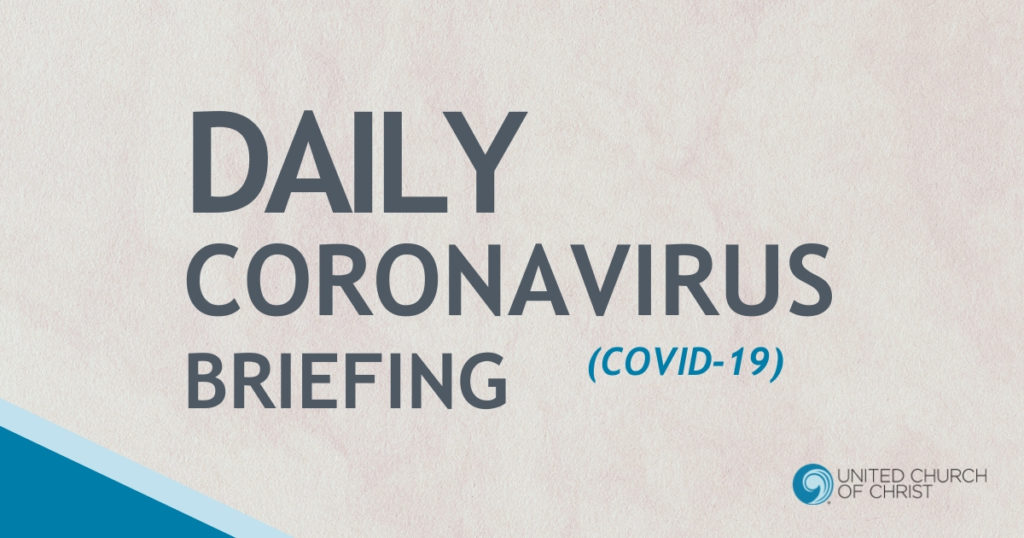COVID reopening guidelines: strengths, gaps
United Church of Christ – Wider Church Ministries
Humanitarian Development Team
Coronavirus (COVID-19) Daily Briefing
Barbara T. Baylor, MPH – Temporary Health Liaison
Strengths, weaknesses of new federal guidelines on “reopening”
Last Thursday, the U.S. government issued new guidelines on “Opening Up America Again.” I think they are a good start – with some gaps and caveats, chiefly that they won’t do any good if we don’t follow them!
Here is a brief recap of the criteria to be satisfied before proceeding to phased reopening.
“Gating” Criteria:
- Downward trajectory (incidence) of influenza-like illnesses AND “covid-like syndromic cases” reported within a 14-day period.
- Downward trajectory of documented cases within a 14-day period or downward trajectory of positive tests as a percent of total tests within a 14-day period.
- Hospitals must treat all patients without crisis care.
- Robust testing program (is) in place for at-risk healthcare workers, including emerging antibody testing.
Core State Preparedness Criteria:
- Ability to quickly set up safe and efficient screening and testing sites for symptomatic individuals with contact tracing.
- Ensure surveillance sites (at locations that serve “older adults, lower-income Americans, racial minorities and Native Americans”) are screening for asymptomatic cases with testing and contact tracing and testing.
Healthcare System Capacity Criteria:
- Ability to quickly and independently supply sufficient Personal Protective Equipment and critical medical equipment to handle dramatic surge in need.
- Ability to surge ICU capacity.
Plans:
- To protect the health and safety of workers in critical issues, of those living and working in high-risk facilities, and employees and users of mass transit.
- To advise citizens regarding protocols for social distancing and face coverings.
- To monitor conditions and immediately take steps to limit and mitigate any rebounds or outbreaks by restarting a phase or returning to an earlier phase depending on severity.
According to the new federal guidelines, the above criteria should be met before proceeding with Phase I (and then II and III) of reopening.
An article in The New York Times explores some positives and challenges of the new guidelines:
Positives:
- It’s a three-phase approach recognizing that reopening is going to be a gradual process. The phases are tied not to strict dates but to metrics.
- Emergency precautions will be scaled according to the intensity of the problem within a given state or region.
- It recognizes that not all businesses and facilities pose equal risks of spreading the coronavirus.
- It emphasizes vulnerable populations and senior living facilities. These facilities will remain at a high risk of explosive growth in cases until we can achieve widespread testing, vaccination and immunity.
Challenges (I would say, “Weaknesses”):
- Testing continues to be a challenge for many states. It is a key metric for determining safe reopening of the country. There is no requirement that states first show that they have tested enough people to establish that the trajectories they are seeing are truly reflective of population-level trends.
- Testing guidelines for many states still focus on testing symptomatic people. To stop the spread of the virus the focus must broaden to asymptomatic coronavirus-infected people who can be unwitting super-spreaders.
- Hospitals are only required to test “at-risk healthcare workers” instead of all health care workers who may be potential sources of risk for spreading the virus.
- States are tasked with “independently” securing personal protective equipment and key equipment such as ventilators, etc. despite the woefully inadequate assistance from the federal government in the supply chain.
- No guidance is given as to how states should “pull back” if a resurgence of cases returns. How will states know when to do this?
Some of the hardest hit states and cities including New York, Massachusetts, New Jersey, California, Pennsylvania, Louisiana (New Orleans), Michigan (Detroit) and Illinois (Chicago) continue struggling to control COVID-19 and are cautiously watching for signs that new infections are decreasing.
Some governors have been forming pacts highlighting the importance of using science and advice from health officials rather than politics to choose when to reopen the economy.
But still other governors have already reopened or have set reopen dates in the coming weeks (including Georgia, Ohio, Tennessee, South Carolina), arguably without fulfilling the prerequisites outlined above for a safe phased reopening.
The Director of the Centers for Disease Control and Prevention (CDC), Dr. Robert Redfield warned in an interview with the Washington Post on Tuesday that a “potentially worse second wave of coronavirus later this year could … coincide with flu season, which could set up a dangerous double whammy for the health care system.”
Might the “rush to reopen America” contribute to that second wave?
Surveys, including a new one released by the Associated Press-NORC Center for Public Affairs Research, find a clear majority of Americans are wary of “reopening” without protection of their health.
I live in Georgia – a state that already has begun to “reopen.” Am I being assured the protections I need? How much risk am I willing to take when guidelines based on science are being ignored and politics and a few protesters are driving the re-openings?
How about you?
References:
Guidelines: Opening Up America Again
Nation’s hot spots see rise in COVID-19 deaths
This is where all 50 states stand on reopening
Related News
Growing Weary
In December 1964 during a speech in Harlem, Fannie Lou Hamer declared: “And you can always...
Read MorePlanning for Earth Month: Resources for Congregations
April is Earth Month, and for congregations, it can be a great time to further discern how...
Read MoreBodily Autonomy Means Every-BODY
Advocacy and Action for Women's and Gender Justice Local events stir thoughts and...
Read More


